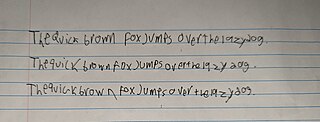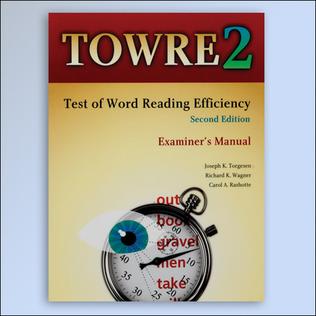
Phonics is a method for teaching reading and writing to beginners. To use phonics is to teach the relationship between the sounds of the spoken language (phonemes), and the letters (graphemes) or groups of letters or syllables of the written language. Phonics is also known as the alphabetic principle or the alphabetic code. It can be used with any writing system that is alphabetic, such as that of English, Russian, and most other languages. Phonics is also sometimes used as part of the process of teaching Chinese people to read and write Chinese characters, which are not alphabetic, using pinyin, which is.

Hyperlexia is a syndrome characterized by a child's precocious ability to read. It was initially identified by Norman E. Silberberg and Margaret C. Silberberg (1967), who defined it as the precocious ability to read words without prior training in learning to read, typically before the age of five. They indicated that children with hyperlexia have a significantly higher word-decoding ability than their reading comprehension levels. Children with hyperlexia also present with an intense fascination for written material at a very early age.
Psycholinguistics or psychology of language is the study of the interrelation between linguistic factors and psychological aspects. The discipline is mainly concerned with the mechanisms by which language is processed and represented in the mind and brain; that is, the psychological and neurobiological factors that enable humans to acquire, use, comprehend, and produce language.

Dysgraphia is a neurological disorder and learning disability that concerns impairments in written expression, which affects the ability to write, primarily handwriting, but also coherence. It is a specific learning disability (SLD) as well as a transcription disability, meaning that it is a writing disorder associated with impaired handwriting, orthographic coding and finger sequencing. It often overlaps with other learning disabilities and neurodevelopmental disorders such as speech impairment, attention deficit hyperactivity disorder (ADHD) or developmental coordination disorder (DCD).
Reading for special needs has become an area of interest as the understanding of reading has improved. Teaching children with special needs how to read was not historically pursued due to perspectives of a Reading Readiness model. This model assumes that a reader must learn to read in a hierarchical manner such that one skill must be mastered before learning the next skill. This approach often led to teaching sub-skills of reading in a decontextualized manner. This style of teaching made it difficult for children to master these early skills, and as a result, did not advance to more advanced literacy instruction and often continued to receive age-inappropriate instruction.
Reading comprehension is the ability to process written text, understand its meaning, and to integrate with what the reader already knows. Reading comprehension relies on two abilities that are connected to each other: word reading and language comprehension. Comprehension specifically is a "creative, multifaceted process" that is dependent upon four language skills: phonology, syntax, semantics, and pragmatics.

Synthetic phonics, also known as blended phonics or inductive phonics, is a method of teaching English reading which first teaches the letter sounds and then builds up to blending these sounds together to achieve full pronunciation of whole words.
A reading disability is a condition in which a person displays difficulty reading. Examples of reading disabilities include: developmental dyslexia, And alexia,

Learning disability, learning disorder, or learning difficulty is a condition in the brain that causes difficulties comprehending or processing information and can be caused by several different factors. Given the "difficulty learning in a typical manner", this does not exclude the ability to learn in a different manner. Therefore, some people can be more accurately described as having a "learning difference", thus avoiding any misconception of being disabled with a possible lack of an ability to learn and possible negative stereotyping. In the United Kingdom, the term "learning disability" generally refers to an intellectual disability, while conditions such as dyslexia and dyspraxia are usually referred to as "learning difficulties".
Enhancing Reading Comprehension through Reciprocal Teaching

Management of dyslexia depends on a multitude of variables; there is no one specific strategy or set of strategies that will work for all who have dyslexia.

Reading is the process of taking in the sense or meaning of letters, symbols, etc., especially by sight or touch.
Language-based learning disabilities or LBLD are "heterogeneous" neurological differences that can affect skills such as listening, reasoning, speaking, reading, writing, and math calculations. It is also associated with movement, coordination, and direct attention. LBLD is not usually identified until the child reaches school age. Most people with this disability find it hard to communicate, to express ideas efficiently and what they say may be ambiguous and hard to understand It is a neurological difference. It is often hereditary, and is frequently associated to specific language problems.
Metalinguistic awareness, also known as metalinguistic ability, refers to the ability to consciously reflect on the nature of language. The concept of metalinguistic awareness is helpful in explaining the execution and transfer of linguistic knowledge across languages. Metalinguistics expresses itself in ways such as:
Dyslexia is a reading disorder wherein an individual experiences trouble with reading. Individuals with dyslexia have normal levels of intelligence but can exhibit difficulties with spelling, reading fluency, pronunciation, "sounding out" words, writing out words, and reading comprehension. The neurological nature and underlying causes of dyslexia are an active area of research. However, some experts believe that the distinction of dyslexia as a separate reading disorder and therefore recognized disability is a topic of some controversy.
Emergent literacy is a term that is used to explain a child's knowledge of reading and writing skills before they learn how to read and write words. It signals a belief that, in literate society, young children—even one- and two-year-olds—are in the process of becoming literate. Through the support of parents, caregivers, and educators, a child can successfully progress from emergent to conventional reading.
Susan Ellis Weismer is a language and communication scientist known for her work on language development in children with specific language impairment and autism spectrum disorder (ASD). She is the Oros Family Chair and Professor of Communication Sciences and Disorders at the University of Wisconsin–Madison, where she is a Principal Investigator and Director of the Language Processes Lab. She has also served as the Associate Dean for Research, College of Letters and Sciences at the University of Wisconsin–Madison.
Kate Nation is an experimental psychologist and expert on language and literacy development in school age children. She is Professor of Experimental Psychology and Fellow of St. John's College of the University of Oxford, where she directs the ReadOxford project and the Language and Cognitive Development Research Group.

Test of Word Reading Efficiency Second Edition or commonly known as TOWRE - 2 is a kind of reading test developed to test the efficiency of reading ability of children from age 6–24 years. It generally seeks to measure an individual's accuracy and fluency regarding two efficiencies; Sight Word Efficiency (SWE) and Phonemic Decoding Efficiency (PDE). SWE measures ability of pronouncing words that are printed and PDE assesses the quantity of pronouncing phonemically regular non-words. TOWRE - 2 is a very simple test which can be administered by teachers and aides, and it only takes five minutes to complete the procedure. It is commonly used in reading research, classroom assessment and clinical practice. This test is both straightforward and easy to use because it does not require a lot of materials and can be administered by teachers and aides.
Jane Oakhill is a British cognitive psychologist and expert on the development of reading comprehension. She holds the position of Professor of Experimental Psychology at the University of Sussex.









